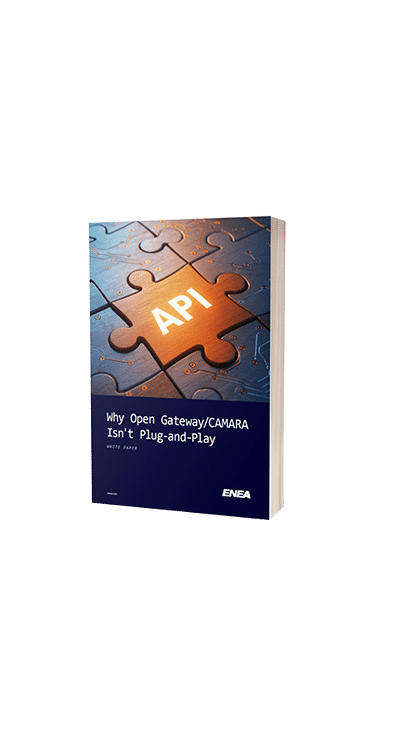CHAPTER 3 – Part 2 (2)
Critical Considerations for Reliable CAMARA API Exposure Services
In our previous post , Chapter 3 Part 1 (2) – CAMARA API Integration Challenges, we talked about the CAMARA API southbound integration challenges facing mobile operators. In this post we will address critical considerations for mobile operators when deploying CAMARA API exposure services.
Currently, most operator-driven use cases focus on exposing core network data for services such as SIM swap detection, number verification, and quality-of-service on demand (as promoted by GSMA).
Even for these relatively straightforward services, the necessary data is often scattered across multiple systems and organizational units within a mobile operator.
CAMARA API White Paper
Download the full
- Executive summary
- The API Exposure Business Opportunity
- CAMARA API Integration Challenges
- The Middleware Solution
- Strategic Directions for Operators
- Our Middleware: The Enea API Composition Engine
Appendix A: The Vision of Open Gateway and CAMARA
Appendix B: Questions You Should Ask Yourself and Your Team
And don’t miss to view our recorded Webinar from June 25, 2025!

CAMARA API Exposure Services
Challenges With Cross-Silo Integrations
As CAMARA API innovations grow in complexity, cross-silo integrations will become essential to ensure seamless data access and interoperability across different operator systems.
Operator data assets are distributed across multiple operational silos, including:
- Core networks
- Business systems
- Customer care systems
Seamless integration across these silos is critical for delivering a cohesive, efficient, and reliable API service. Note that it is not always about technology, but also about organizational ownership.
Challenges in 4G and 5G Integration
Operators have leveraged off-the-shelf NEF (Network Exposure Function) solutions for 5G, but there is no equivalent standardized solution for exposing 4G core network data.
Key limitations and challenges include:
- The NEF solutions from core network vendors only expose predefined 3GPP-specified endpoints.
- Custom expansions to NEF often require alignment with vendor roadmaps, creating dependency risks.
- Since an NEF may be limited to HTTP/2 and REST interfaces, MNOs must develop their own exposure functions for pre-5G networks and legacy systems, supporting a variety of protocols such as Diameter, RADIUS, and SS7.
- Providing 4G and 5G data via a unified API remains a significant challenge, requiring integration across multiple silos.
Ensuring Sustainability and Reliability
Operators must commit to API-related SLAs to ensure consistent service delivery. Robust throttling and load control mechanisms—such as caching—are essential to manage API traffic effectively, preventing latency issues and avoiding overload of core network systems.
They also need reliable CDR and statistics capabilities to ensure accurate usage tracking and prevent revenue leakage.
Security Considerations for CAMARA API Exposure Services
Ensuring secure API access requires robust authentication mechanisms, such as API keys, to verify and control usage. Additionally, strong authentication and validation mechanisms help prevent unauthorized access, ensuring the integrity and confidentiality of exposed APIs.




